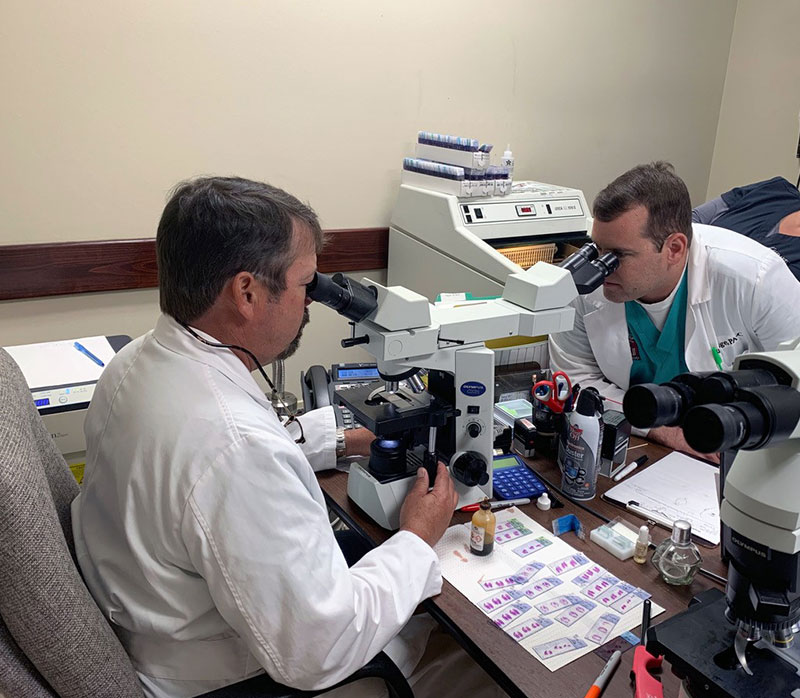Mohs Surgery
Surgical removal of the visible portion of skin cancer, along with a layer of the surrounding skin.
Mohs Surgical Overview
In Mohs surgery, the dermatologist performs the dual role of skin cancer surgeon and pathologist. The Mohs procedure involves the surgical removal of the visible portion of the skin cancer, along with a layer of the surrounding skin. This tissue is then divided into sections and color-coded by the Mohs surgeon, while corresponding reference marks are made on the patient to indicate the source from which each section was taken. The surgeon then draws a map of the surgical site, and the tissue is processed to create microscope slides for examination and analysis by the physician. He or she then examines the undersides and edges of each section microscopically for evidence of remaining cancer cells. If cancer is still present, the involved areas are carefully marked on the map and the patient is prepared to undergo removal of another layer of tissue. It is important to note that any additional tissue is removed only from the area(s) in which cancer cells are still evident on microscopic examination. This process is repeated until no further evidence of cancer remains at the surgical site.
Indications for Using Mohs Surgery
Mohs surgery is indicated for skin cancers in anatomic areas in which preservation of the maximum amount of surrounding healthy tissue is critical for functional and/or cosmetic purposes, such as the eyelids, nose, ears, fingers, toes, and genitalia. It is also used to excise previously-treated skin cancers which have recurred over time, skin cancer containing scar tissue, large skin cancers, skin cancers with borders that are not clearly defined, and skin cancers that demonstrate certain unusual growth patterns. Skin cancers with aggressive subtypes, such as sclerosing or infiltrating basal cell carcinomas, also may require the use of Mohs surgery. The dermatologist will consider a number of factors in determining whether Mohs surgery is indicated for a particular skin cancer.
Mohs Effectiveness
Clinical studies have demonstrated that Mohs surgery provides five-year cure rates approaching 99% for new cancers and 95% for recurrent cancers. Important advantages of the Mohs procedure are that it allows the greatest amount of surrounding healthy tissue to remain intact, potentially reducing the size of the final surgical defect and resulting scar; and that the methodical manner in which all lateral and deep tissue margins are examined enables the surgeon to detect and remove any “roots” of the skin cancer that may be present, which greatly reduces the likelihood of recurrence.
Mohs Surgery Patient Brochure
View the brochure for more information. The button below downloads a PDF file with more information.

Mohs Training and Experience
Residency training in dermatology provides the basic skill set from which the Mohs technique is derived: skin cancer pathology, cutaneous histopathology, dermatologic surgery, and the repair of complex surgical defects. The Mohs surgeon continues to enhance these skills in Residency and once in practice through repeated observation and performance of the Mohs tecnique. Challenging medical education courses with an emphasis on Mohs surgery, observational preceptorship training with other highly-experienced Mohs surgeons, and formal Mohs fellowships all are available options for post-Residency Mohs training. Each experience encourages further advancement and refinement of the dermatologist’s surgical skills and enables him or her to treat progressively more complex Mohs cases.
Team Approach to Skin Cancer Treatment
In an effort to provide the best possible medical care, Mohs surgeons sometimes treat patients in partnership with other specialists such as oculoplastic surgeons, ENT (ear, nose and throat) specialists, oral surgeons, plastic surgeons, and radiation oncologists. If indicated for your condition, your Mohs surgeon will discuss these options in detail with you.
Grafton Dermatology
Grafton Dermatology and Cosmetic Surgery is a team of dedicated, board-certified physicians and caring professionals.
Service Areas
Serving Terrebonne, Lafourche, Assumption, St. Mary, St. James, St. John the Baptist, and St. Charles Parishes using the latest in dermatological breakthroughs.
